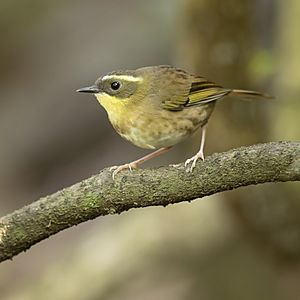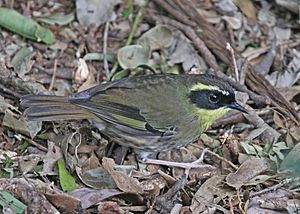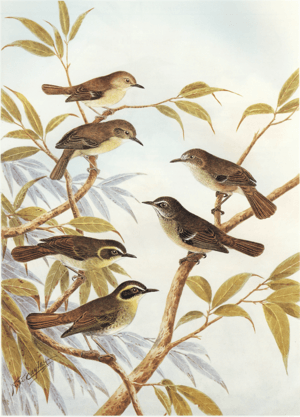Yellow-throated scrubwren facts for kids
Quick facts for kids Yellow-throated scrubwren |
|
|---|---|
 |
|
| Conservation status | |
| Scientific classification | |
| Genus: |
Neosericornis
|
| Species: |
citreogularis
|
| Subspecies | |
|
|
| Synonyms | |
|
Sericornis citreogularis |
|
The yellow-throated scrubwren (Neosericornis citreogularis) is a small songbird. It belongs to the Acanthizidae family. You can find this bird in parts of eastern coastal Australia. It used to be in the Sericornis group. Now, it is the only species in its own group, called Neosericornis.
This little bird lives on the ground in wet forests or rainforests. It mainly eats insects. The yellow-throated scrubwren has a special yellow throat and a yellow stripe above its eye. Male birds have a black face, while females have a brown face. Their upper body is dark or olive-brown. Their belly is cream, white, or light olive. The wings are dark brown with yellow edges. These birds can breed many times in a long season. They build large, pear-shaped nests that hang down. Often, these nests are built over water. They look a lot like flood debris, and are often placed near it. The nests are also favorite sleeping spots for the golden-tipped bat (Phoniscus papuensis).
Contents
About the Yellow-throated Scrubwren Name
The yellow-throated scrubwren was first described in 1838. An English bird artist named John Gould gave it the scientific name Sericornis citreogularis. The name citreus means 'like citrus' or 'yellow'. The word gula means 'throat'. So, the name means 'yellow-throated'.
In 1912, a part of this bird family was named cairnsii by Gregory Mathews. Scientists used to place the yellow-throated scrubwren in the Sericornis group. But in 2018, they studied the bird's DNA. They found it was not closely related to other scrubwrens. Because of this, the bird was moved to a new group. This new group is called Neosericornis. Mathews had suggested this name back in 1912. The name Neosericornis comes from old Greek words. Neos means 'new', serikos means 'silken', and ornis means 'bird'.
What the Yellow-throated Scrubwren Looks Like
The yellow-throated scrubwren is about 12.5 to 15 cm (5 to 6 inches) long. Male birds have a black face and black ear feathers. They have a bright yellow throat and a yellow stripe above their eye. Their eyes are reddish. The upper part of their body is brownish, and their belly is lighter. Their wing feathers are yellow. They have long, pinkish or cream-colored legs.
Female birds look a bit different. They have a brownish face instead of black. These birds make different sounds. They have a loud, harsh chattering call. They also sing a lively song. Sometimes, their song can be a response to a loud noise. For example, they might sing after a car door slams.
Where Yellow-throated Scrubwrens Live
You can find these birds in two separate areas. One area is in coastal north Queensland. This stretches from Cooktown to Townsville. The other area is from Hervey Bay in southern coastal Queensland. It goes south through southeastern New South Wales.
They usually live in rainforest gullies. These are small valleys, often with streams nearby. In the Sydney Basin, they might live in the Illawarra escarpment. They also live in wetter places in the Dharug National Park and Royal National Park.
These birds eat insects. They find their food on the ground. Another bird, the large-billed scrubwren (S. magnirostris), lives in the same wet forests. But that bird looks for food higher up in leaves and on branches.
Reproduction and Nests
The breeding season for these birds can last a long time. It can go from June all the way to March. A pair of birds might have two or more groups of babies in one season.
Their nest is quite large. It is made from long pieces of dried grasses, leaves, and small sticks. They also use palm fibers, bark, and feathers to line the inside. The nest is shaped like a pear. It hangs above the ground or above water. It is usually suspended from a vine or a branch. The nest can look like flood debris. Because of this, they are often built near actual flood debris.
The female bird lays two or three eggs. The eggs are oval-shaped and about 26 by 18 mm (1 by 0.7 in). Their color can be brownish-purple or pale brownish-white. They have darker spots or blotches. The larger end of the eggs usually has a darker cap of color.
Sometimes, the birds will add another room to their nest in later years. These nests are also favorite daytime resting spots for the golden-tipped bat (Phoniscus papuensis).
See also
 In Spanish: Sedosito gorjigualdo para niños
In Spanish: Sedosito gorjigualdo para niños




